

Next Gen Personal Finance. Curriculumbrianshim2016-12-31T11:06:50+00:00 Next Gen Personal Finance offers a free online curriculum of 65+ complete lessons and 100+ standalone activities you can access from anywhere.

Here, you can preview all our lessons and activities and easily access them on the Gooru platform. “HELP! I spend hours and hours searching for great resources, and often I can’t find what I’m looking for!” We know how frustrating and exhausting it can be to find great resources. “HELP! Finding the resource is only half the battle. “HELP! Next Gen Personal Finance. Futures Definition. Error loading plugin: Plugin file not found Share Video undefined.
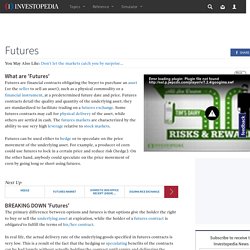
AutoGuide. Jump$tart. Financial Capability Study. Auto. Simply stated, auto insurance is a contract between you and your insurance company that protects you against financial loss if you have an accident.
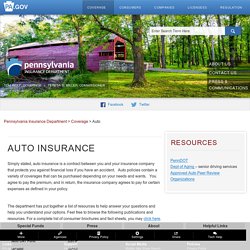
Auto policies contain a variety of coverages that can be purchased depending on your needs and wants. You agree to pay the premium, and in return, the insurance company agrees to pay for certain expenses as defined in your policy. The department has put together a list of resources to help answer your questions and help you understand your options. Feel free to browse the following publications and resources. For a complete list of consumer brochures and fact sheets, you may click here. Auto Insurance Guide Download a PDFAuto Insurance Questions and Answers Download a PDFAuto Insurance Glossary Download a PDFAuto Insurance Fact Sheet Download a PDF New WreckCheck App for Smartphones - The NAIC has developed WreckCheck, a new, free mobile app for iPhone® and Android® smartphones. Insure U Get Smart About Insurance. High School Financial Planning Program. Hands on Banking. FDIC: Teacher Resource Center. Next Gen Personal Finance.
Clearinghouse. Welcome to the Jump$tart Clearinghouse, the premier online library of financial education resources, for teachers, parents, caregivers and anyone committed to financial smarts for students.
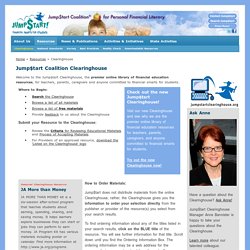
How to Order Materials: Jump$tart does not distribute materials from the online Clearinghouse; rather, the Clearinghouse gives you the information to order your selection directly from the publisher or provider of the resource(s) you select from your search results. To find ordering information about any of the titles listed in your search results, click on the BLUE title of the resource. You will see further information for that title. Scroll down until you find the Ordering Information Box. Jump$tart Clearinghouse Disclaimer The Jump$tart Clearinghouse staff use the Criteria for Reviewing Educational Materials as a guide in the selection of materials to be included in the database.
National Endowment for Financial Education. Dollars & Sense. Making Finance Personal: Project-Based Learning for the Personal Finance Classroom - Federal Reserve Bank of Atlanta. Skip to content Publications.
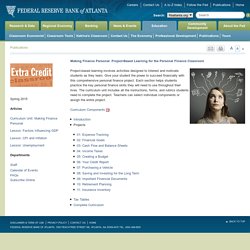
Financial Literacy & Financial Education from Better Money Habits. Home Buying Tips from Better Money Habits. When to use a debit card or credit for Better Money Habits. Alright, let’s talk about credit and debit cards.
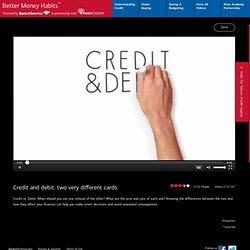
Both are used in place of cash to pay for things you buy. Both are convenient and accepted almost everywhere. Both are made of plastic and probably in your wallet right now. And both offer some kind of fraud protection and security, especially when compared to cash. But do you really know the advantages and disadvantages of each? Let’s start by taking a look at your daily routine. Here’s the thing: It’s a question we hear almost every day, but don’t really think about that much. All good questions, and the best way to answer them is to take a look at the pros and cons associated with each. A credit card is also a payment method, but instead of tapping into your own money, your purchase is paid for temporarily using someone else’s money — like the bank or card issuer.
Okay, now for the pros and cons. Www.consumer-action.org/downloads/english/2009_Bankruptcy_Lesson.pdf. Missouri Department of Higher Education. Insurance 101… in a Flash. Www.dhe.mo.gov/files/SAS_Companion.pdf. Utah Education Network. SPENT. Home - Missouri Council for Economic Education. Teens Guide To Money. The Stock Market Game™ - Home. Lessons & Workshops. What do your students know about life insurance and how it works?
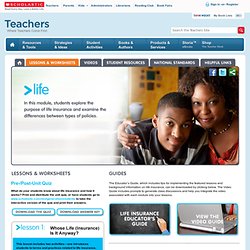
Print and distribute the unit quiz, or have students go to www.scholastic.com/nextgeneration/students to take the interactive version of the quiz and print their answers. Students evaluate the financial standing and future obligations of a couple with two children and determine if their life insurance policy will enable them to meet their future financial needs and goals. Student Activity: Better Safe (PDF) To help them understand the purpose of life insurance, students will brainstorm portraits of fictional characters and then examine their financial obligations to assess how these responsibilities would be met if the character passed away.
Student Activity: Who Needs Life Insurance? The Educator’s Guide, which includes tips for implementing the featured lessons and background information on life insurance, can be downloaded by clicking below. Foundationsu.com. The Million Dollar Mystery Athletes blow money the same way the rest of America blows money.
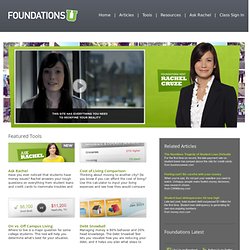
There's no difference! Family Economics and Financial Education.